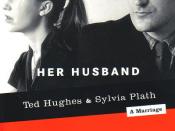Poetry often allows its audience to gain meaningful messages which have been deliberately left behind by their creators. Two poems which deal with the representations of women are Ted Hughes "The Minotaur" and Sylvia Plath's "The Rival". The major difference between the themes of these two poems is that while Hughes uses the poem to express his contempt of women, Plath bemoans the exploitation and pain they receive. Both attempt to expose dissatisfaction and victimisation through using different techniques, including context and concerns, poetic devices and poetic structure.
The context and concerns of Plath and Hughes are vital in people's interpretation and understanding of their poems and ideas. Plath and Hughes were once married, but their relationship broke down, leaving much dissatisfaction with the opposing party from each side. We can infer that Plath refers to Hughes in her poem as the character was male - "spiteful as a woman, but not so nervous" and had rivalled her in poetry.
For example, she believed he stole her limelight, labelling him as a "light borrower". Hughes refers to "your children" who were left behind as Plath as she committed suicide. Clearly, poetry can be an important messenger in the depiction of ideas in a poem, as we can now understand the reasons for Plath seeking sympathy for women while Hughes wished to attack them.
Structure is the first eye-catching device employed by poets to give depth and convey ideas. For example, the dialogue in Hughes' poem brings his story of frustration with women to life. It gives a sense of dramatic immediacy. The angry "smash it!" quickly allows the audience to gain an insight into Hughes' mind. The way his poem is divided into a furious first section and a plainly contemptuous second section follows the idea that women's destruction...



Directions......
try to make sure you follow the directions for titling your essay and describing it. Only the title goes in the title spot, the description of the assignment and/or an overview of the paper should be the first paragraph in the essay section
0 out of 0 people found this comment useful.